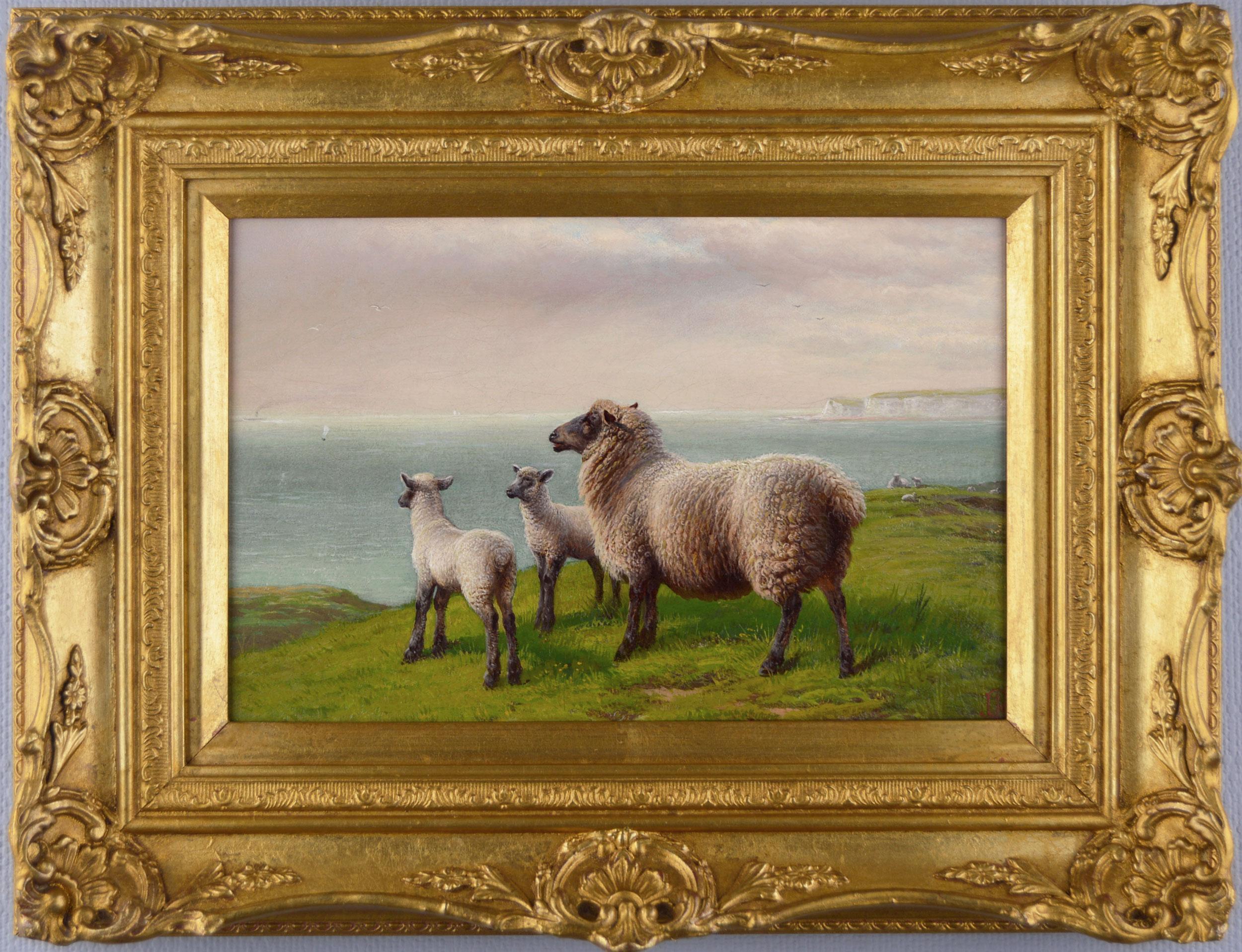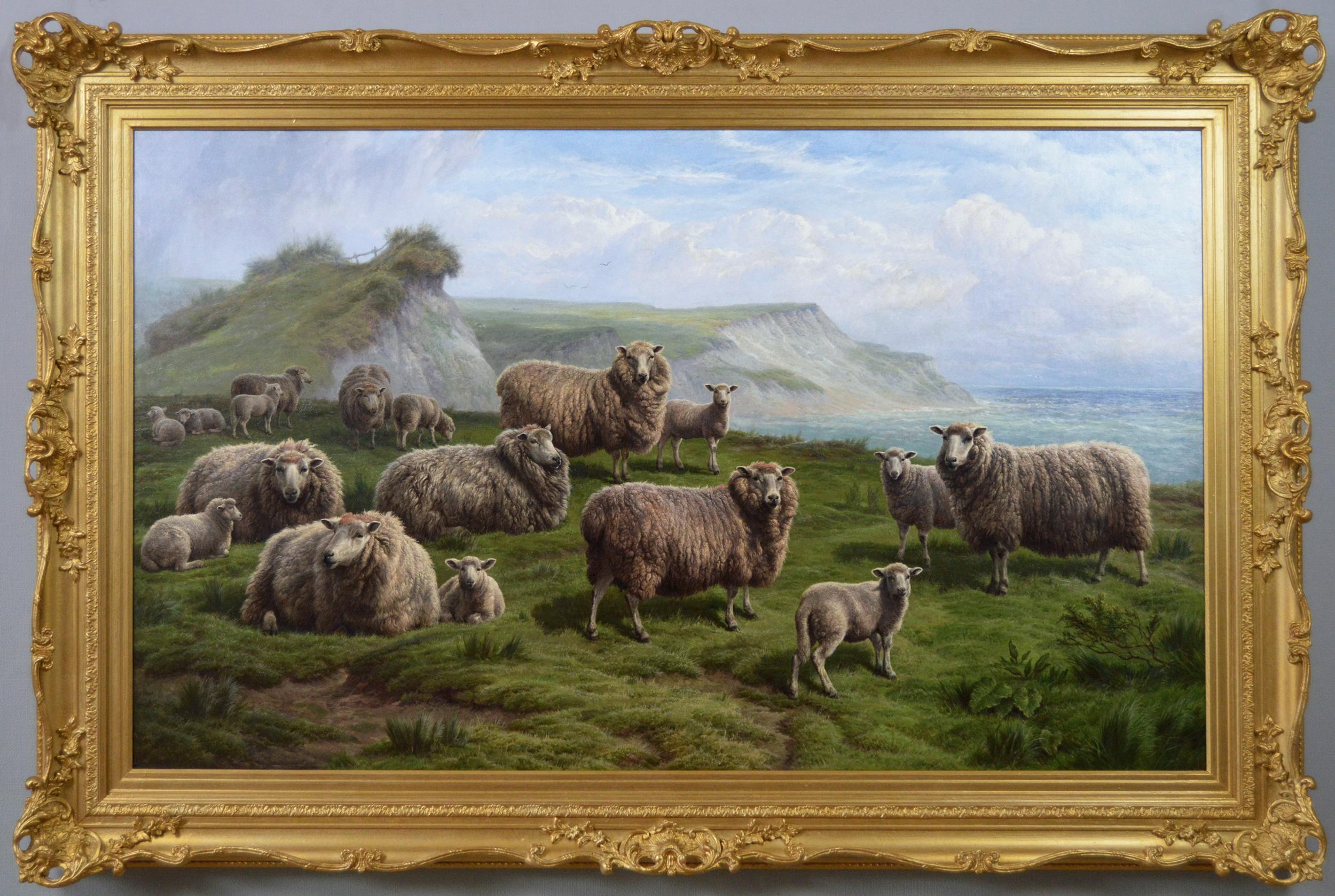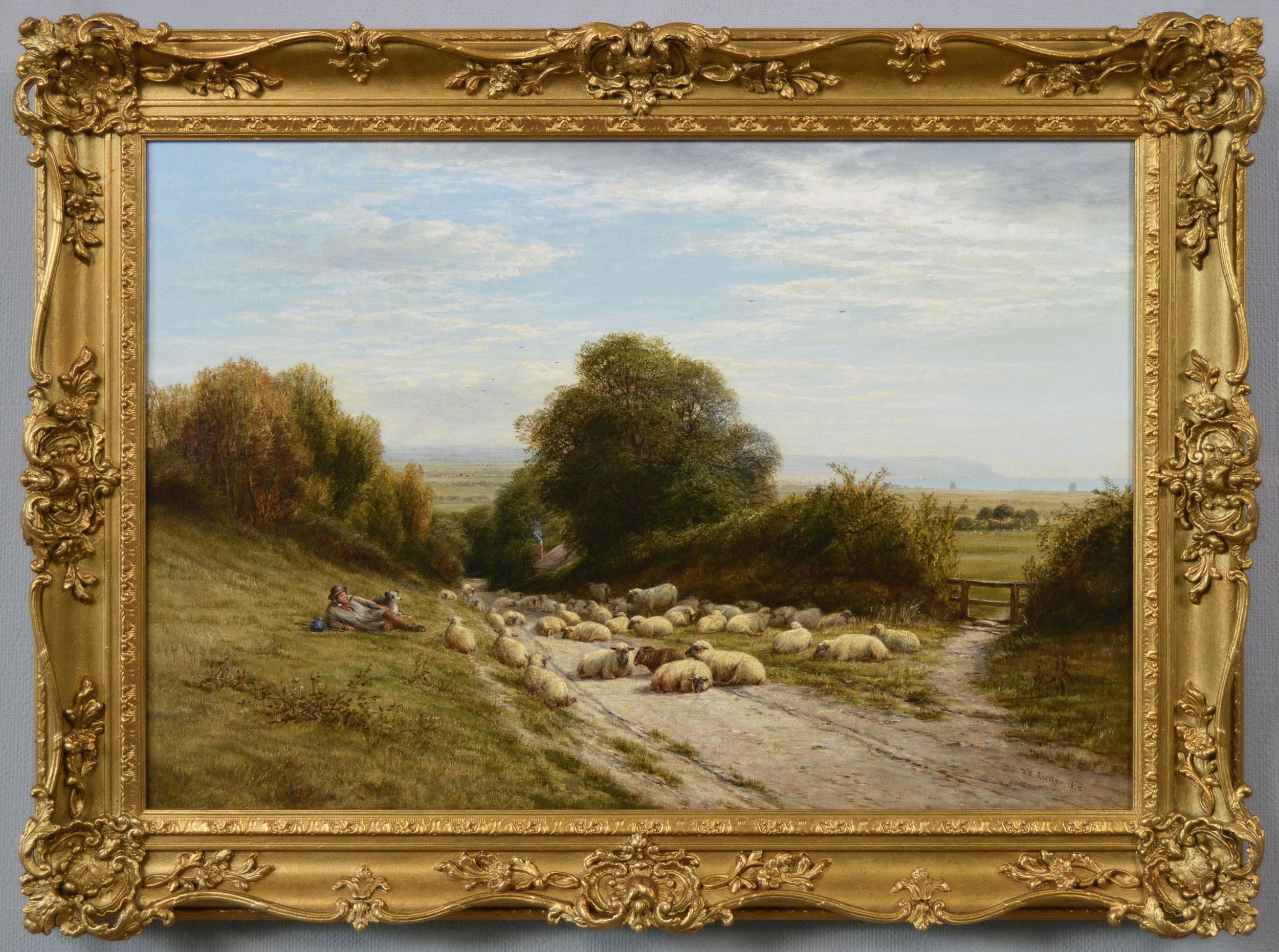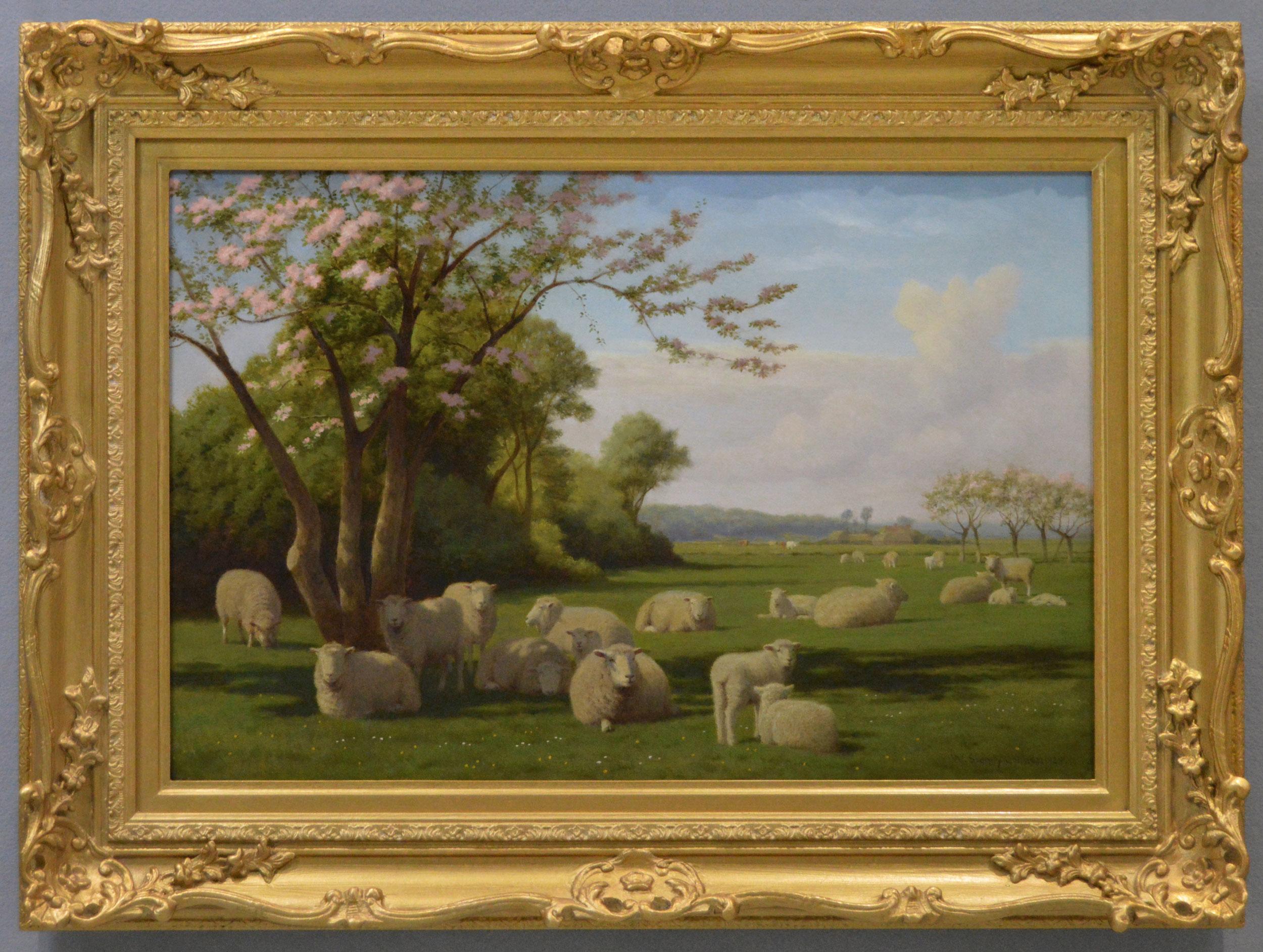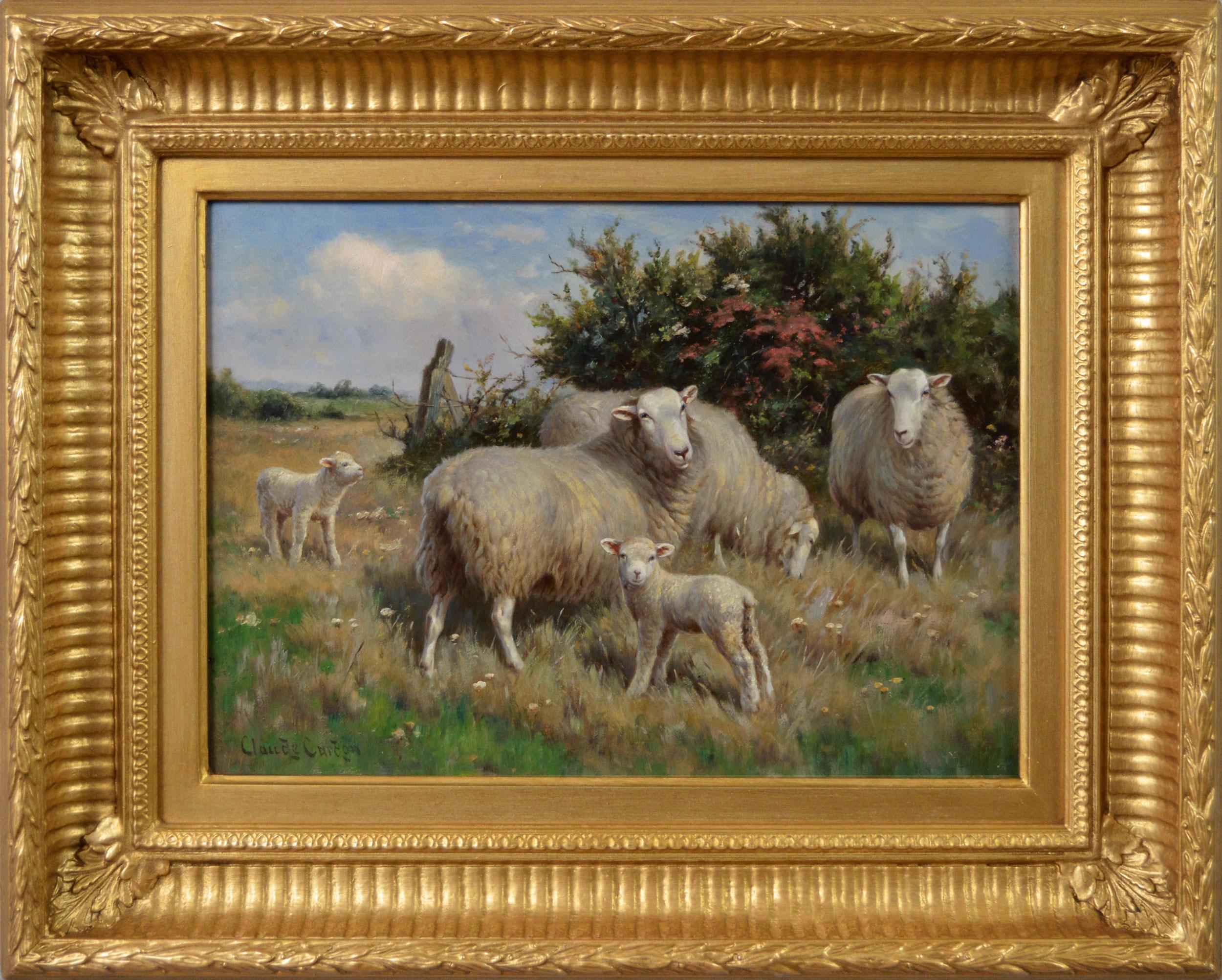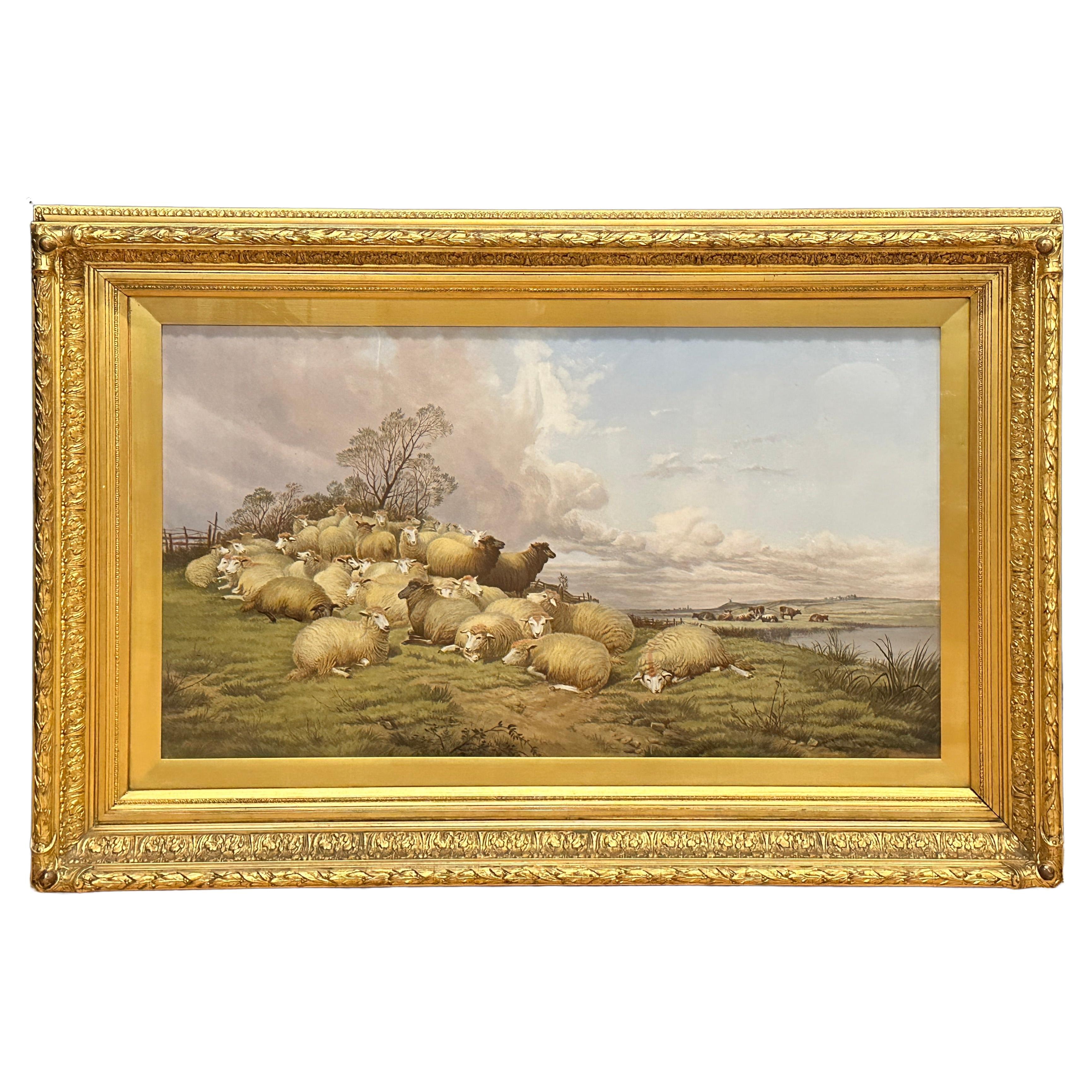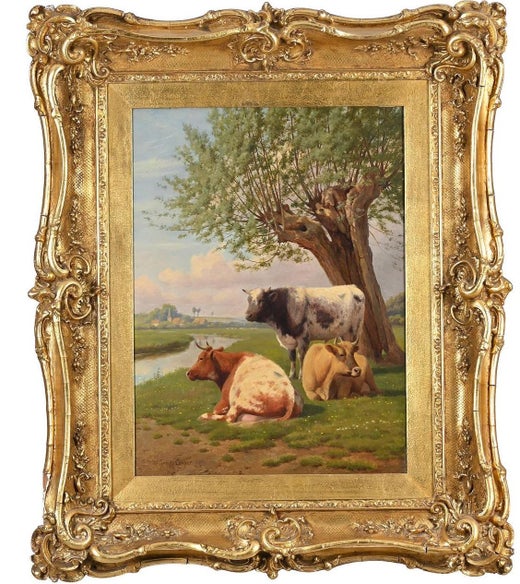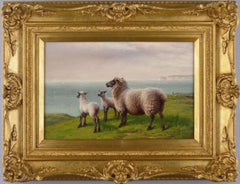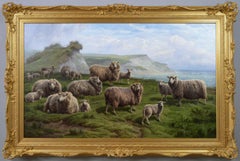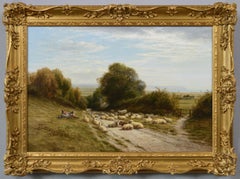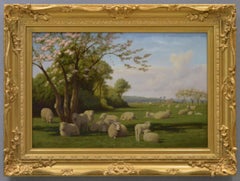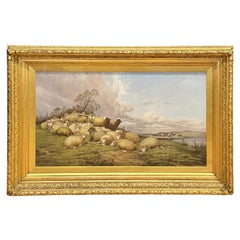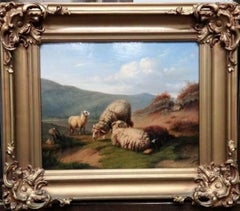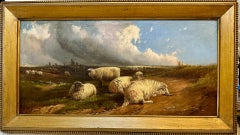Items Similar to 19th Century landscape oil painting of sheep on a clifftop near Herne Bay, Kent
Want more images or videos?
Request additional images or videos from the seller
1 of 16
William Sidney Cooper19th Century landscape oil painting of sheep on a clifftop near Herne Bay, Kent1923
1923
$8,015.47
£5,850
€6,823.71
CA$10,979.20
A$12,211.26
CHF 6,376.34
MX$148,598.09
NOK 81,435.62
SEK 76,372.25
DKK 50,927.96
Shipping
Retrieving quote...The 1stDibs Promise:
Authenticity Guarantee,
Money-Back Guarantee,
24-Hour Cancellation
About the Item
William Sidney Cooper
British, (1854-1927)
Near Herne Bay, Kent
Oil on canvas, signed & dated 1923, inscribed in pencil on stretcher
Image size: 19.5 inches x 29.5 inches
Size including frame: 26.75 inches x 36.75 inches
A delightful painting of sheep and their lambs on a cliff top overlooking Herne Bay, Kent by William Sidney Cooper. In the far distance can be seen the distinctive ruins of Reculver Abbey, which is also the site of a Roman Fort. At the time of this painting, Cooper was living in Cecil Park, Herne Bay and painted a number of scenes of the area.
William Sidney Cooper was born in Canterbury, Kent in 1854 and was the son of John Ramsay Cooper, a dispensary chemist and Mary Barber. He was the great nephew of Thomas Sidney Cooper (1803-1902), the famous landscape painter. His talent for painting was recognised early on and he trained under his great uncle at the Canterbury Sidney Cooper School of Art.
In 1881, he started exhibiting at the Royal Academy and Suffolk Street and later at the Royal Watercolour Society. Works at the RA include ‘Springtime, Isle of Wight’, ‘The Avon at Ringwood’ and ‘Twilight on the Thames’. He married Kate Kennett in 1882 and they lived in Pangbourne, Berkshire where they had their first 3 children. In 1890, they moved to Herne Bay in Kent, living at 18 William Street where their last 2 children were born. Sometime after 1913 he moved to live at Glenthorne, Cecil Park in Herne Bay.
Like his great uncle, he painted sheep and cattle in landscapes, often set within the countryside of Herne Bay. As well as a talented artist, Cooper was also a musician and a keen golfer and involved himself with his local community. He died on 9 September, 1927 aged 73 and is buried in Eddington Churchyard. His works are highly collectable and can be found amongst many private collections as well as museums and art galleries including: Canterbury Museum, Cartwright Hall Art Gallery, Cliffe Castle Museum, Ferens Art Gallery, Hampshire Cultural Trust, Maidstone Museum and Reading Museum.
Presentation: The work is housed in a new, English made gilt frame which is in excellent condition.
Condition: As with all of our original antique oil paintings, this work is offered in ready to hang gallery condition, having just been professionally cleaned, restored and revarnished.
© Benton Fine Art
- Creator:William Sidney Cooper (1854 - 1927, British)
- Creation Year:1923
- Dimensions:Height: 26.75 in (67.95 cm)Width: 36.75 in (93.35 cm)Depth: 3 in (7.62 cm)
- Medium:
- Period:
- Condition:
- Gallery Location:Nr Broadway, GB
- Reference Number:1stDibs: LU156213099722
William Sidney Cooper
William Sidney Cooper trained at the Canterbury art school of his great-uncle, Thomas Sidney Cooper (1803–1902). Like his mentor, the younger Cooper specialised in landscapes, often with livestock, but the latter became particularly famous for his paintings of cattle. He exhibited at the Royal Academy, the Royal Society of British Artists and the Royal Watercolour Society.
About the Seller
5.0
Platinum Seller
Premium sellers with a 4.7+ rating and 24-hour response times
Established in 1972
1stDibs seller since 2015
338 sales on 1stDibs
Typical response time: <1 hour
Associations
The British Antique Dealers' AssociationLAPADA - The Association of Arts & Antiques DealersInternational Confederation of Art and Antique Dealers' Associations
- ShippingRetrieving quote...Shipping from: Nr Broadway, United Kingdom
- Return Policy
Authenticity Guarantee
In the unlikely event there’s an issue with an item’s authenticity, contact us within 1 year for a full refund. DetailsMoney-Back Guarantee
If your item is not as described, is damaged in transit, or does not arrive, contact us within 7 days for a full refund. Details24-Hour Cancellation
You have a 24-hour grace period in which to reconsider your purchase, with no questions asked.Vetted Professional Sellers
Our world-class sellers must adhere to strict standards for service and quality, maintaining the integrity of our listings.Price-Match Guarantee
If you find that a seller listed the same item for a lower price elsewhere, we’ll match it.Trusted Global Delivery
Our best-in-class carrier network provides specialized shipping options worldwide, including custom delivery.More From This Seller
View All19th Century landscape oil painting of sheep grazing on a clifftop
By Charles Jones (b.1836)
Located in Nr Broadway, Worcestershire
Charles Jones
British, (1836-1892)
Sheep Grazing on a Cliff Top
Oil on canvas, signed with monogram
Image size: 7.5 inches x 11.5 inches
Size including frame: 13.5 inches x 17.5 inches
A lovely landscape painting of sheep on a coastal cliff by Charles ‘Sheep’ Jones. The sheep and her two lambs are depicted against the backdrop of the sea with shipping and chalk cliffs in the distance. The location is likely to be the Devon coast, an area Jones visited often.
Charles Jones was an animal painter who was born in Stepney, London in 1836. He was the son of the artist Samuel John Egbert Jones (1797-1861) and Dinah Jones. He lived with his parents and 9 siblings in Mile End and was a pupil of his father. In September 1859, he married Frances Rosalinda Downe, who was born in America. His son Arthur Bertram Loud (1863-1930) also became an artist. They lived at 12 Hayes Place, Lisson Grove from where he made his debut in London at the Royal Academy in 1861. He also exhibited at the British Institution, Suffolk Street, New Watercolour Society, Royal Institute of Oil Painters and the Royal Institute of Painters in Watercolours.
By 1867, he had become a successful artist and had moved to 7 Paragon Place, Brixton Hill. From 1874, he lived at Heathercroft, Balham Hill where he spent the rest of his life. As well as the major London galleries, he also exhibited provincially at various locations including: the Royal Cambrian Academy where he was elected a member in 1886, the Glasgow Institute of Fine Arts, Manchester City Art Gallery, Royal Hibernian Academy, Royal Society of British Artists, Birmingham and the Walker Art Gallery, Liverpool. Some of the smaller more intimate galleries he exhibited at were Arthur Tooth & Sons and Thomas Richardson...
Category
19th Century Victorian Animal Paintings
Materials
Oil, Canvas
19th Century exhibition size landscape oil painting of Sheep on a cliff
By Charles Jones (b.1836)
Located in Nr Broadway, Worcestershire
Charles Jones
British, (1836-1892)
Sheep Resting
Oil on canvas, signed with monogram & dated 1877, further inscribed verso
Image size: 35 inches x 59 inches
Size including frame: 47 inches x 71 inches
Exhibition Size Painting
A fantastic exhibition sized landscape painting of sheep on a cliff top by the coast by Charles ‘Sheep’ Jones. At the time he produced this painting, Jones was living at Heathercroft, Balham Hill in London. Given the size and quality of the work it was most likely an exhibition piece. The topography and landscape suggest that this is the Dorset coast, one of his favourite places to paint.
Charles Jones was an animal painter who was born in Stepney, London in 1836. He was the son of the artist Samuel John Egbert Jones (1797-1861) and Dinah Jones. He lived with his parents and 9 siblings in Mile End and was a pupil of his father. In September 1859, he married Frances Rosalinda Downe, who was born in America. His son Arthur Bertram Loud (1863-1930) also became an artist. They lived at 12 Hayes Place, Lisson Grove from where he made his debut in London at the Royal Academy in 1861. He also exhibited at the British Institution, Suffolk Street, New Watercolour Society, Royal Institute of Oil Painters and the Royal Institute of Painters in Watercolours.
By 1867, he had become a successful artist and they had moved to 7 Paragon Place, Brixton Hill. From 1874 he lived at Heathercroft, Balham Hill where he spent the rest of his life. Jones became well known for specialising in paintings of sheep, cattle and deer in landscape settings. He spent his time travelling around visiting areas such as Devon, Dorset, Kent, Sussex and the Highlands. However, it is for his skilful painting of sheep that he is perhaps best known, and for which earned him the nickname of ‘Sheep’ Jones.
As well as the major London galleries, he also exhibited provincially at various locations including: the Royal Cambrian Academy where he was elected a member in 1886, the Glasgow Institute of Fine Arts, Manchester City Art Gallery, Royal Hibernian Academy, Royal Society of British Artists, Birmingham and the Walker Art Gallery, Liverpool. Some of the smaller more intimate galleries he exhibited at were Arthur Tooth & Sons and Thomas...
Category
19th Century Victorian Animal Paintings
Materials
Canvas, Oil
19th Century landscape oil painting of sheep in a Sussex lane
By William Luker Sr.
Located in Nr Broadway, Worcestershire
William Luker Snr
British, (1828-1905)
Sheep in a Sussex Lane with Pevensey Bay in the distance
Oil on canvas, signed & dated 1875
Image size: 17.25 inches x 25.25 inches
Size including frame: 23.25 inches x 31.25 inches
A tranquil landscape scene of a shepherd and his flock resting in a lane near Pevensey Bay, Sussex by William Luker. The ruins of Pevensey Castle can be seen in the distance with the sea beyond.
William Luker Snr was born in 1828 at Faringdon, Berkshire to William and Jane Luker (née Charlwood). His father was a plumber and glazier by trade and the family lived at London Street in Faringdon. Little is known about his early education and it is believed for the most part he was self -taught. However, given the quality of his work and the fact that his family were able to keep a servant, he may well have received some artistic tuition.
By the early 1850’s, he had begun earning a living as an artist by advertising in local directories, earning commissions from local landowners. He made his debut at the Royal Society of British Artists in 1851 and was a prolific exhibitor there for over 40 years. He began exhibiting at the Royal Academy in 1852 and also exhibited at the British Institution.
He married the artist Ada Augusta Margetts (1839-1930) on 27 October 1864. Their eldest son William Luker Jnr (1867-1951) also became a well-known artist. The couple soon moved to London where they lived at 22 Gloucester Terrace, Campden Hill from where they both exhibited. From 1867, they lived at 15 Sheffield Terrace in Kensington until 1874 when they moved for the final time to 22 Notting Hill Square, later renamed Campden Hill Square in 1893. He died at Campden Hill-square on 28 February, 1905.
Luker specialised in landscapes featuring animals such as sheep and cattle, horses and deer. He travelled around visiting areas such as Sussex, Buckinghamshire, Kent, Wales and the Highlands. However, he also made trips to Egypt and Libya producing a series of Oriental scenes in the early 1860’s. His works show a great attention to detail and his use of a lighter palette gives his subjects a luminous quality that instantly attracts the viewer. Examples of his paintings are held by the Atkinson Art Gallery, National Library of Wales, Newstead Abbey...
Category
19th Century Victorian Paintings
Materials
Canvas, Oil
19th Century landscape animal oil painting of sheep by a tree
By William Sidney Cooper
Located in Nr Broadway, Worcestershire
William Sidney Cooper
British, (1854-1927)
Springtime at Herne, Kent
Oil on canvas, signed & dated 1925, inscribed in pencil verso
Image size: 15.5 inches x 23.5 inches
Size includi...
Category
Early 20th Century Animal Paintings
Materials
Canvas, Oil
19th Century landscape animal oil painting of sheep with lambs
By Claude Cardon
Located in Nr Broadway, Worcestershire
Claude Cardon
British, (1864-1937)
Spring Lambs
Oil on canvas, signed
Image size: 9.5 inches x 13.5 inches
Size including frame: 16.25 inches x 20.25 inches
A charming painting of ...
Category
19th Century Victorian Animal Paintings
Materials
Canvas, Oil
19th Century landscape animal oil painting of cattle & sheep by a river
By Thomas Sidney Cooper
Located in Nr Broadway, Worcestershire
Thomas Sidney Cooper
British, (1803-1902)
Canterbury Meadows
Oil on canvas, signed & dated ‘T. Sidney Cooper RA/1894
Image size: 14.75 inches x 24.75 i...
Category
19th Century Victorian Animal Paintings
Materials
Canvas, Oil
You May Also Like
Antique Oil Painting Sheep In Landscape By D.H. Winder
Located in Norwood, NJ
Fine quality early 20th century oil on board of a Herd of sheep in a landscape pasture. Signed and dated 1916 by D.H. Winder.
Daniel H Winder (1870 - c.1920) was active/lived in Uni...
Category
Early 20th Century British Paintings
Materials
Canvas, Glass, Wood, Giltwood, Paint
19th century oil Highland Scottish sheep in a Highland Lock Landscape
Located in Woodbury, CT
19th century Scottish Highland Sheep in a landscape.
A Scottish 19th century Highland landscape painting featuring Highland sheep by Vincent Collier offers more than just aesthetic ...
Category
1890s Victorian Animal Paintings
Materials
Canvas, Oil
Sheep In A Landscape, 19th Century, Follower Of Eugene Verboeckhoven
Located in York, GB
A fine painting of sheep in a landscape setting follower of the talented Belgium painter of animals
Eugene Verboeckhoven. Housed in a 19th century gilt frame. The size overall being 55 cm x 48 cm whilst the painting
is 38 x 29 cm.
The sheep have been beautifully captured especially their faces. An oil on board study ready to hang
Eugene Joseph Verboeckhoven...
Category
19th Century Old Masters Animal Paintings
Materials
Oil
Victorian 19th century Moorland landscape with Sheep grazing and resting
Located in Woodbury, CT
Owning a 19th century English Victorian landscape by John Duvall, particularly one featuring sheep resting circa 1880, offers a unique opportunity to own...
Category
1880s Victorian Landscape Paintings
Materials
Canvas, Oil
Antique Landscape Oil Painting of Sheep by Lauren de Beul circa 1864
Located in Shippensburg, PA
LAURENT DE BEUL
Belgium, 1821-1872
Shepherd Boy, Dog and Flock in Landscape (1864)
Oil on panel signed with a certifying statement in the artist's hand verso "Je soussigné, déclar...
Category
Antique 19th Century Belgian Romantic Paintings
Materials
Paint
Oil on canvas : Cattle near the cliffs of Herne Bay KENT by Thomas Syndey Cooper
By Thomas Sidney Cooper
Located in Gent, VOV
Thomas Sidney Cooper was one of the foremost animal painters of the Victorian period. He was born in Canterbury, Kent, and as a small child he began to show strong artistic inclinations, but the circumstances of his family did not allow him to receive any systematic training. By the time he was twelve years old, he was working in the shop of a coach painter. Later he obtained a job as a scene painter, and he alternated between these two occupations for about eight years. He still felt a strong desire to become an artist, and all his spare moments were spent drawing and painting from nature. At the age of twenty, he went to London, drew for a while in the British Museum, and was admitted as a student of the Royal Academy. Subsequently, he returned to Canterbury, where he was able to earn a living as a drawing master and by the sale of sketches and drawings.
In 1827, he settled in Brussels and married before taking up a position as a teacher in Brussels in 1829. There he befriended Eugène Joseph Verboeckhoven, the great Belgian animal painter, who greatly influenced his style. He was also influenced by the 17th Century Dutch School. Because of the Belgian Revolution, he returned to London where he settled and first exhibited at Suffolk Street in 1833. He exhibited forty-eight pictures at the British Institution between 1833 and 1863. ‘Landscape and Cattle’, Royal Academy 1833, was shown until 1902 without a break - a record for a continuous exhibit at the Royal Academy. Sheep and cattle were his most frequent subjects, although he did paint a few figurative subjects. Cooper collaborated between 1847 and 1870 with Frederick Richard Lee...
Category
1880s Realist Landscape Paintings
Materials
Canvas, Oil
Thomas Sidney CooperOil on canvas : Cattle near the cliffs of Herne Bay KENT by Thomas Syndey Cooper
$23,004 Sale Price
20% Off
More Ways To Browse
Set Of 3 Oil Paintings
Paintings of Sheep
Kent Oil Paintings
Cooper Oil Painting
Oil Painting Of Sheep
Antique Sheep Painting
Sheep Oil On Canvas
Antique Oil Painting Of Castle
Abbey Painting
William Kent
19th Century Painting Of Castle
William A Cooper
19th Century Painting Sheep
Golf Painting Framed
Lamb Oil Painting
19th Century Painting Suffolk
British Sheep Painting
Roman Ruins Painting
